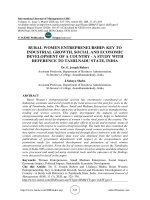Economic growth and economic development 388
Bạn đang xem bản rút gọn của tài liệu. Xem và tải ngay bản đầy đủ của tài liệu tại đây (89.97 KB, 1 trang )
Introduction to Modern Economic Growth
grows at the rate n, starting with L (0) = 1, so that total population is
(8.2)
L (t) = exp (nt) .
All members of the household supply their labor inelastically.
Our baseline assumption is that the household is fully altruistic towards all of its
future members, and always makes the allocations of consumption (among household
members) cooperatively. This implies that the objective function of each household
at time t = 0, U (0), can be written as
Z ∞
exp (− (ρ − n) t) u (c (t)) dt,
(8.3)
U (0) ≡
0
where c (t) is consumption per capita at time t, ρ is the subjective discount rate, and
the effective discount rate is ρ − n, since it is assumed that the household derives
utility from the consumption per capita of its additional members in the future as
well (see Exercise 8.1).
It is useful to be a little more explicit about where the objective function (8.3)
is coming from. First, given the strict concavity of u (·) and the assumption that
within-household allocation decisions are cooperative, each household member will
have an equal consumption (Exercise 8.1). This implies that each member will
consume
C (t)
L (t)
at date t, where C (t) is total consumption and L (t) is the size of the representative
c (t) ≡
household (equal to total population, since the measure of households is normalized
to 1). This implies that the household will receive a utility of u (c (t)) per household
member at time t, or a total utility of L (t) u (c (t)) = exp (nt) u (c (t)). Since utility
at time t is discounted back to time 0 with a discount rate of exp (−ρt), we obtain
the expression in (8.3).
We also assume throughout that
Assumption 4’.
ρ > n.
This assumption ensures that there is in fact discounting of future utility streams.
Otherwise, (8.3) would have infinite value, and standard optimization techniques
would not be useful in characterizing optimal plans. Assumption 4’ makes sure that
374









